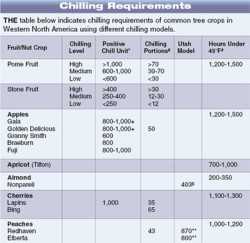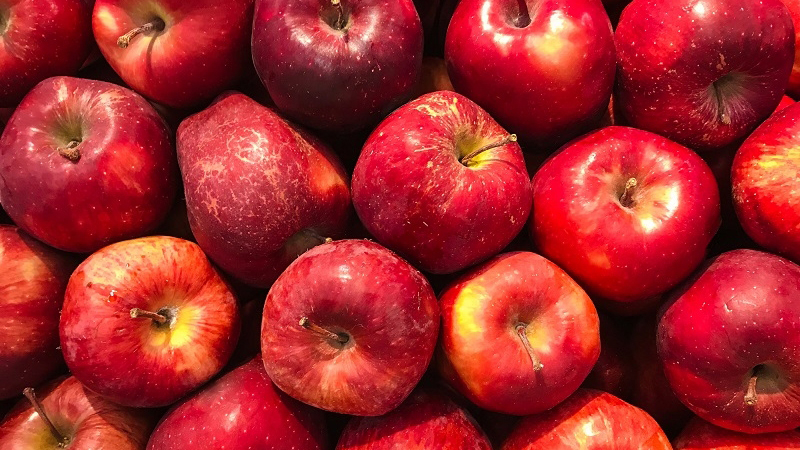Using A Chilling Model To Determine Yield

One common coffee house question this time of year in fruit and nut growing regions is “Is it a good chilling year?” The amount of chilling a perennial crop accumulates in a given winter will influence bloom conditions — the most crucial time in a crop season. Less chilling than a certain tree crop requires can lead to an extended bloom; too little altogether can result in bud death and drop in some crops like apricot and sweet cherry. “Good chilling” (more chilling than the minimum required) can produce a very short bloom season, or “snowball bloom.”
Chilling models can provide growers and their advisers with key information to time dormancy-breaking materials (hydrogen cyanamide, oil, etc.) to manipulate bloom to improve or maintain yield and quality in regions where local chilling is marginal for a certain crop. Climate change may make achieving critical chilling more important in years to come.
Deciduous perennial crops break bud in the late winter or spring after a certain amount of cold weather (chilling) followed by a certain amount of warmer weather. Think of this process as a relay race. The chilling is the first leg of the race, and the heat accumulation is the second leg. Bud break is the finish line. The length of each leg of the race depends on crop and variety. The weather during the race influences the runner’s speed. Good chilling weather speeds up the chilling leg, while warmer weather can slow it down or even stop it. Cool weather on the warming leg slows the progress towards bloom.
Matching Variety With Climate
Since most perennial crops are not native to North America, matching the chilling and heat requirements of a variety to the climate of a given orchard site is key to sustainable production. To get an idea of when the baton handoff occurs in the race to bloom, chilling models are used. These models are the product of decades of research. Chilling models represent our understanding of how a part of nature works. (We’re making some progress)
Prior to 1970, the most commonly used chilling model was based on hours under 45°F (1 hour below 45°F is a “chill hour”). The “Modified Chill Hour” model measures chilling as 1 hour at or below 45°F. In California, chilling accumulation measurement traditionally begins on November 1 and ends on March 1.
These timings are based on historical averages, but chilling can accumulate earlier and later as well, when a chilling model is used to start and stop the clock. Annual chilling hour (CH) accumulation sums all the hours under 45°F (or hours ≤ 45°F) between those dates.
Subsequent research and experience showed that chilling as the plant perceives it is more complicated than just hours under 45°F. Winter temperatures below freezing provide no metabolically effective chilling. Temperatures between freezing and 54°F provide chilling along a sliding scale around an optimum of 45°F to 47°F. Chilling units may be lost when temperatures reach above 60°F. This research resulted in several new models to explain plant blooming behavior in relation to weather in the dormant season.
The first of these was developed by researchers at Utah State University. Known as the Utah Model, it accounts for the negation of chilling by high winter temperatures. Each hour of the day was given positive, negative, or no chilling units based on the temperature in that hour. The Utah model works well in temperate growing regions of the world with generally cold winters, such as continental regions of North America. It doesn’t accurately track chilling in coastal growing regions where warm winter temperatures are common and cold periods alternate with warm periods.
Newer Models
A new model was developed in Israel in the late 1980s. It incorporated research showing that high temperatures negate chilling, but only within a period under 48 hours. The Dynamic Model measures chilling in units called chilling portions (CP). One portion equals 28 hours at 6°C (43°F), or more than 28 hours at somewhat less effective temperatures (44°F to 55°F). The Dynamic Model accumulates fewer chilling units (called portions) for the same site compared to the other models — for example, a dormant season of 1,500 CH may “equal” 95 CP. The Dynamic Model is complex and requires hourly data and a computer to calculate. It is also the most accurate of the chilling models currently available.
South African researchers modified the Utah Model by ignoring negative chilling units accumulated over a 24-hour period. If negative chilling units are accumulated over a 24-hour period, the total is just “zeroed out.” This model is referred to as the Daily Positive Utah Chilling Model. This model performs similarly to the Dynamic Model.
Where does all this leave a fruit or nut grower wishing to use the most accurate chilling model currently available? The Dynamic Model and the Positive Utah Chilling Model work well in cold or warm winter climates. The Utah Model works well in cold winters, but not in warm ones. The under 45°F model is dated, but will tell you if it’s a cold winter or warm winter. Chilling units required for adequate chilling for a range of tree crops using several different models are listed in the table on page 16. These data were obtained from a range of sources and should be considered general chilling targets.
Where can you go to track chilling accumulation? California growers (or anyone else) can log onto http://fruitsandnuts.ucdavis.edu and click on “Weather Services” to look at current and historical chilling accumulations from automated weather stations around the state. Several models are available at this site. A how-to guide for using the Dynamic Model from online data or a data logger set up in an orchard (including how to use a data logger) can be obtained on the same site at http://groups.ucanr.org/treecrop/How-To_Guides and a copy of the Dynamic Model program can be downloaded with the how-to guide. Any computer set up to run Excel can use the Dynamic Model program with publicly-accessed weather data or data logger data from your own orchard. To run the Utah Model using your own weather data, visit the New Mexico University’s http://weather.nmsu.edu/nmcrops/Trees/apples/
chilldly.htm. Other Web resources may be available.
* Info from South African Deciduous Fruit Cultivars catalogue reported in KZN Agri-Report No. N/A/2002/02
€ Info from A. Erez. Temperate Fruit Crops in Warm Climates, 2000. Kluwer Academic Publishers.
# Info from K. Ryugo Fruit Culture. 1988. Wiley Co.
** Info from HortScience 9(4): 331-332 (1974)
$ Info from Environ. Exp. Bot. 61:254-263 (2007)










